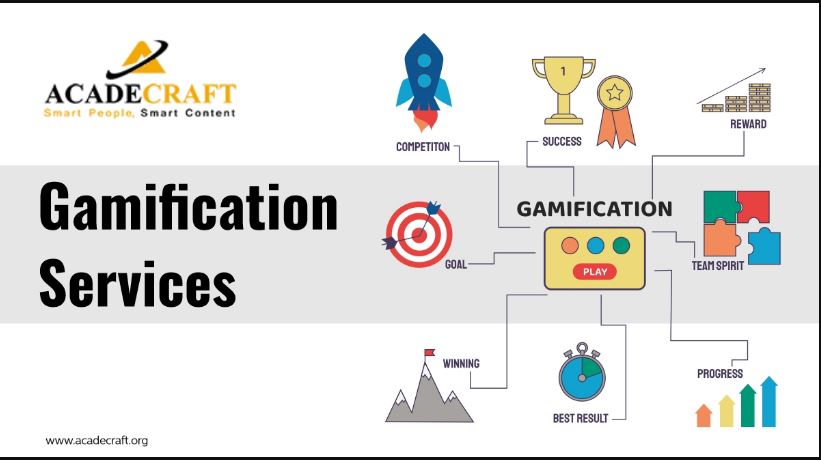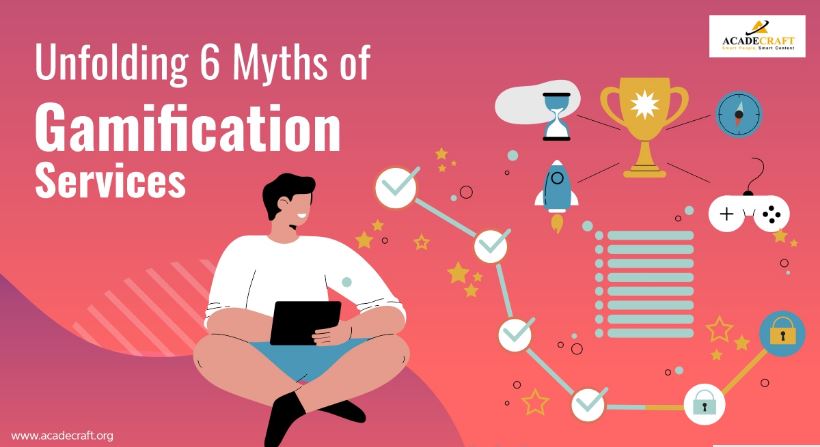Who doesn’t like games? From a five-year-old kid to a sixty-year-old adult, games are a go-to option for all! Such is the craze of games that gamification services have taken a front seat in the corporate world!
With the rise in gamification, numerous myths have come to the forefront. While some myths hardly create a hush, some others are making it difficult for companies to make a decision.
So, here we are with our solution! We’ll unfold the six common myths about gamification. Tighten your seat belt and hop on to the journey of exploring the myths and digging out the truth.
What’s Not True about Gamification Services?
Myth 1: Games, Game-based Learning, and Gamification are the same things
No, they are not! Games, game-based learning, and gamification all have different purposes.
We play games for fun. Games keep us entertained and indirectly play a role in motivating and making us aware of certain situations. It’s fun and relaxing.
Game-based learning, however, isn’t just about fun. Game-based learning creates a learning environment where the games are specifically developed and designed for educational purposes.
Moreover, Game-based learning helps the learners acquaint themselves with new skills and concepts. Game-based learning isn’t limited to education. It covers staff awareness training, team building, and others.
On the other hand, gamification employs game ideologies and elements in non-game contexts. The main aim of gamification is to achieve specific results and encourage desired behaviors.
In gamification solutions, developers incorporate game mechanics into training content to get productive learning outcomes.
If you wonder whether gamification is only used to create engaging training materials, you are mistaken! The list of gamification’s utility is endless. From learning a new language to meditation and fitness, gamified applications are beneficial to all!
The next time, if you hear anyone blending games, game-based learning, and gamification together, show them this!
Myth 2: Gamification is Only about Leader boards and Badges
Again, a big no! Gamification isn’t only about leader boards and badges. There’s a lot more to it. Leader boards, badges, and rewards are essential strategies in gamification, but they can’t be just put up in a module.
Along with the extrinsic rewards, gamification also takes care of intrinsic motivation. Gamification services focus both on extrinsic and intrinsic goals to make learning effective.
For example, in a training program, gamification improves engagement, brings happiness, and incorporates a positive attitude.
It’s not me who’s saying it! There’s no trust without facts. So, let’s dig in a few statistics.
Reports suggest that employee happiness is boosted by 89% in a gamified workplace. Moreover, 90% of employees feel more productive using gamification modules.
Incorporating leader boards, badges, and rewards in a training module doesn’t do the job. A company’s gamification strategy must align with the training goals.
Myth 3: Gamification Services are only for the New Age Learners
This myth is one of the most talked-about problems of gamification. Companies worry about their senior employees in regards to incorporating gamification elements.
A survey states that 97% of employees (aged 45+) claimed gamified activities improved their work quality. Moreover, another report says that 58% of visitors were 45 years or above in a gamification campaign!
The people who think that the older generation is more inclined to a classroom-based training can now wide open their eyes!
Undoubtedly, the older generation might be reluctant to use newer age technologies, but nothing can stop them if appropriately taught. Gamification has no age barrier in its usage.
As already mentioned, the main goal of gamification is to encourage a desired behavioral change and motivate them. And, motivation doesn’t require an age group!
So, the myth that gamification solutions are just for new-age learners is false.
Myth 4: Gamification in Training Modules is a Distraction
Are they? No! Rather than distracting employees, gamification improves engagement levels and productivity rates.
The world doesn’t believe claims but pure facts. So here are a few conclusions from various reports.
- 96% of employees enjoy tasks with gaming elements.
- A survey states that 89% of respondents claimed that gamified elements encourage them to complete the tasks.
- Adult learners gain colossal benefits from gamified elements. There’s a 14% improvement in skill-based tests with gamification and an 11% improvement in factual knowledge tests.
- Another report states that 85% of employees show more engagement with gamification solutions incorporated in their workplace training programs.
- A study has shown an increase of 48% in employee engagement with gamification modules.
Inculcating gamification elements doesn’t make learning inefficient but supplements it. With gamification, employees benefit from hands-on training and a motivational approach as well.
Gamification in corporate training can help employees learn new concepts, acquire skills and influence their behavior within a course.
Myth 5: There’s no Approved Science behind Gamification
Who says that?
Did you know that gamification was created around the concept and idea of motivational psychology?
A book by Brian Burke, Gamify: How Gamification Motivates People to Do Extraordinary Things, breaks down three essential values of gamification initiatives to motivate users.
- Autonomy
- Mastery
- Purpose
These motivators, Burke states, focus on intrinsic values like self-building and social rewards. These motivators, again, correlate with Martin’s PERMA model.
The PERMA model focuses on five principles:
- Positive emotion
- Engagement
- Relationship
- Meaning
- Accomplishments
Good gamification services always ensure to take these psychological factors in mind! So, there’s no weight in the myth that gamification has no science behind it!
Myth 6: Gamification is Easy to Develop
Gamification doesn’t simply mean incorporating rewards, achievements, or badges in a training module. It’s more than that!
Without a proper plan, no company can incorporate gamification modules constructively. An instructional design strategy is necessary for the effective inculcation of gamified elements.

The learning objectives need to be clear, and developers must design the content with gamification modules accordingly.
- Adding rewards and badges must help the learners at different points of instruction.
- The gamified story incorporated in the module must capture the mood of the learning experience.
- The leader board and achievements must play a role in increasing learners’ motivation and not distracting them.
Creating a gamified module is not a piece of cake. It needs in-depth research and adequate skills. So, the myth of gamification being easy to develop can be negated.
Final Words
With the gamification market soaring high up, numerous myths will do rounds. But, adequate research and in-depth knowledge on gamification are necessary before making any decision. There are a plethora of providers offering gamification services. Among them, Acadecraft is the best bet! With us, you can customize your gamification modules and inspire learners to be better in each step of the training program.




